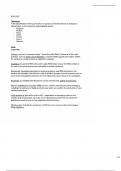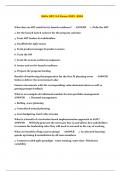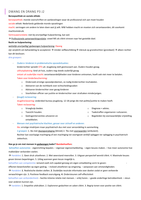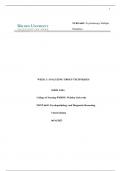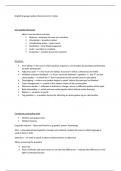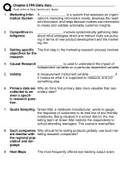Genetics and Genetic engineering
What is Genetics?
Studies hereditary and variation in orgs
Explains differences and similarities btwn parents and offspring
Genes and Alleles:
Each chromatid is made up of 1 helical DNA molecule
Each DNA mol is made up of genes
Gene = a section of DNA that controls hereditary chareristics
Almost all somatic cells have an exact copy of all genes
Each cell contains 2 of each type of gene (paternal and maternal
chromosomes)
Gene pool = set of all genes/genetic info in a sexually reproductive
organism
The larger the gene pool, the larger the
chance of survival
How active are genes?
Only genes that are needed are activated, while others are suppressed diff
genes are activated in diff cells, creating the specific proteins needed to give a
cell its certain characteristics (e.g brain cells, bone cells etc.)
House keeping genes = genes that are active in many different cells
(makes proteins for basic functions)
Master control cell/ hox genes = determines the way in which the body
develops from a single zygote
Epigenetics = the control of genes
Alleles:
Alternate forms of the same gene
Representation of Alleles:
Dominant = capital
The alleles that has an effect on both homozygous and heterozygous
conditions
Recessive = lower case
Alleles which only effects homozygous recessive conditions
How are alleles passed from parent to offspring?
Gametes carry chromosomes
Homozygous dominant = BB
Heterozygous = Bb
1
, Homozygous recessive = bb
Summary:
Somatic cells = normal body cells (diploid/2n), they have a pair of
homologous chromosomes and 2 alleles.
Sex cell (gametes) are haploid (n), they have 1 pair of homologous
chromosomes and 1 of each pair of alleles
What happens to the gametes?
During fertilization male and female gametes fuse to form diploid zygote
(This divideds and divides to form org)
Each cell has the same set of chromosomes and alleles as in the zygote
Genotype = all genes carried on chromosomes inherited from parents
Phenotype =physical appearance of an org (affected by genotype and external
factors)
Monohybrid crosses
= Cross btwn parent w// different alleles for a single trait
Test cross
If an organism shows a dominant phenotype, how do we know if it is
homo/heterozygous for the dominant trait?
The only way to find out is to cross an unknown dominant organism with an
individual showing the recessive phenotype
If offspring is dominant = the org is homozygous
If cross’s offspring is recessive = heterozygous
Punnet square:
2
What is Genetics?
Studies hereditary and variation in orgs
Explains differences and similarities btwn parents and offspring
Genes and Alleles:
Each chromatid is made up of 1 helical DNA molecule
Each DNA mol is made up of genes
Gene = a section of DNA that controls hereditary chareristics
Almost all somatic cells have an exact copy of all genes
Each cell contains 2 of each type of gene (paternal and maternal
chromosomes)
Gene pool = set of all genes/genetic info in a sexually reproductive
organism
The larger the gene pool, the larger the
chance of survival
How active are genes?
Only genes that are needed are activated, while others are suppressed diff
genes are activated in diff cells, creating the specific proteins needed to give a
cell its certain characteristics (e.g brain cells, bone cells etc.)
House keeping genes = genes that are active in many different cells
(makes proteins for basic functions)
Master control cell/ hox genes = determines the way in which the body
develops from a single zygote
Epigenetics = the control of genes
Alleles:
Alternate forms of the same gene
Representation of Alleles:
Dominant = capital
The alleles that has an effect on both homozygous and heterozygous
conditions
Recessive = lower case
Alleles which only effects homozygous recessive conditions
How are alleles passed from parent to offspring?
Gametes carry chromosomes
Homozygous dominant = BB
Heterozygous = Bb
1
, Homozygous recessive = bb
Summary:
Somatic cells = normal body cells (diploid/2n), they have a pair of
homologous chromosomes and 2 alleles.
Sex cell (gametes) are haploid (n), they have 1 pair of homologous
chromosomes and 1 of each pair of alleles
What happens to the gametes?
During fertilization male and female gametes fuse to form diploid zygote
(This divideds and divides to form org)
Each cell has the same set of chromosomes and alleles as in the zygote
Genotype = all genes carried on chromosomes inherited from parents
Phenotype =physical appearance of an org (affected by genotype and external
factors)
Monohybrid crosses
= Cross btwn parent w// different alleles for a single trait
Test cross
If an organism shows a dominant phenotype, how do we know if it is
homo/heterozygous for the dominant trait?
The only way to find out is to cross an unknown dominant organism with an
individual showing the recessive phenotype
If offspring is dominant = the org is homozygous
If cross’s offspring is recessive = heterozygous
Punnet square:
2


